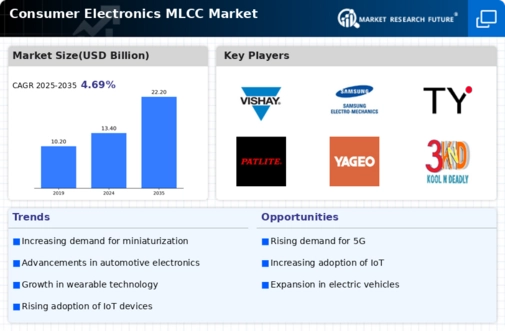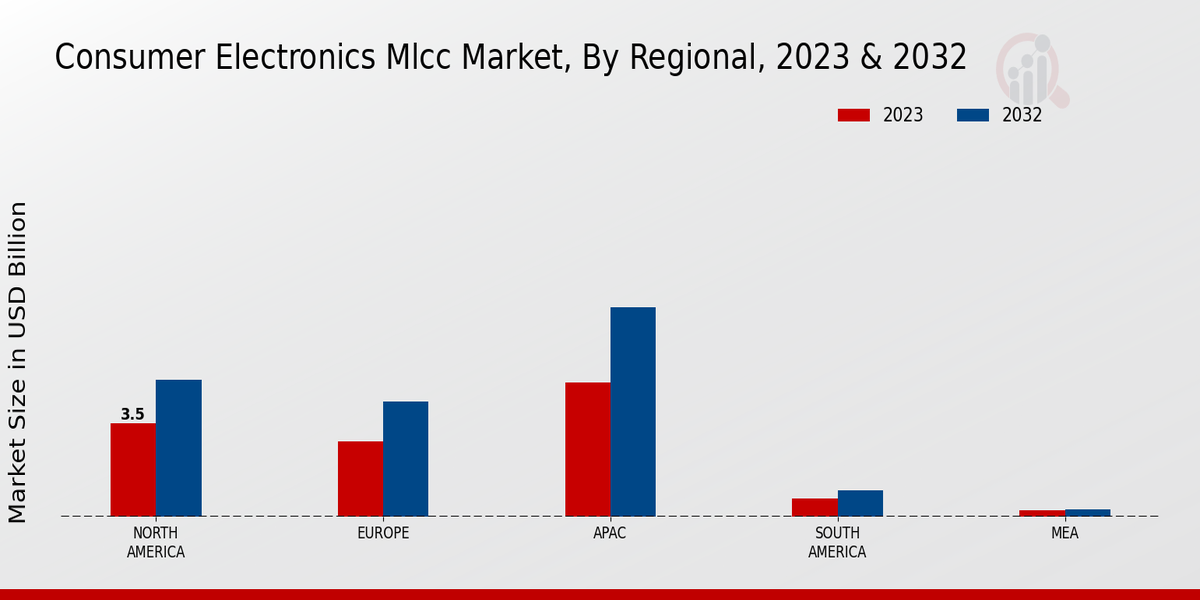Market Growth Projections
The Global Consumer Electronics MLCC Market Industry is poised for substantial growth, with projections indicating a market value of 22.2 USD Billion by 2035. This anticipated growth reflects the increasing integration of MLCCs in various consumer electronics applications, driven by technological advancements and rising consumer demand. The market is expected to experience a compound annual growth rate (CAGR) of 4.69% from 2025 to 2035, suggesting a steady expansion trajectory. Such projections highlight the importance of MLCCs in the evolving landscape of consumer electronics, as manufacturers strive to meet the growing needs of consumers and adapt to emerging technologies.
Growth of Electric Vehicles
The rise of electric vehicles (EVs) plays a pivotal role in shaping the Global Consumer Electronics MLCC Market Industry. As automotive manufacturers increasingly integrate advanced electronic systems into their vehicles, the demand for high-quality MLCCs escalates. These components are essential for managing power distribution, signal processing, and energy storage in EVs. The expansion of the EV market is expected to contribute significantly to the overall growth of the MLCC sector, with projections indicating a compound annual growth rate (CAGR) of 4.69% from 2025 to 2035. This trend underscores the importance of MLCCs in the automotive industry, further diversifying their application.
Technological Advancements in MLCC
Technological innovations in MLCC manufacturing processes significantly influence the Global Consumer Electronics MLCC Market Industry. Enhanced production techniques, such as the development of multilayer ceramic capacitors, allow for smaller, more efficient components that cater to the miniaturization of electronic devices. These advancements not only improve performance but also reduce costs, making MLCCs more accessible to manufacturers. As the industry evolves, the introduction of new materials and designs is likely to enhance the reliability and longevity of MLCCs, thereby attracting more investment and driving market growth. This trend aligns with the projected market growth to 22.2 USD Billion by 2035.
Increased Focus on Energy Efficiency
The Global Consumer Electronics MLCC Market Industry is witnessing a heightened emphasis on energy efficiency across various sectors. As consumers and manufacturers alike prioritize sustainability, the demand for energy-efficient electronic devices rises. MLCCs, known for their low power consumption and high reliability, are increasingly favored in the design of energy-efficient products. This shift not only aligns with global sustainability goals but also encourages innovation in capacitor technology. As a result, manufacturers are likely to invest in research and development to create more efficient MLCCs, thereby enhancing their market position and contributing to the overall growth of the industry.
Rising Demand for Consumer Electronics
The Global Consumer Electronics MLCC Market Industry experiences a robust demand driven by the increasing consumption of consumer electronics such as smartphones, laptops, and wearable devices. As of 2024, the market is valued at approximately 13.4 USD Billion, reflecting a growing trend in electronic device adoption. This surge is attributed to advancements in technology and consumer preferences for high-performance devices. The proliferation of smart home devices and IoT applications further fuels this demand, indicating a shift towards more interconnected living environments. Consequently, manufacturers are compelled to enhance their production capabilities to meet this escalating need.
Regulatory Support for Electronic Components
Regulatory frameworks supporting the electronics industry significantly impact the Global Consumer Electronics MLCC Market Industry. Governments worldwide are implementing policies that promote the use of advanced electronic components, including MLCCs, to enhance product performance and safety. Such regulations often encourage manufacturers to adopt higher standards in production, which can lead to improved quality and reliability of MLCCs. This supportive environment fosters innovation and investment in the sector, potentially driving market growth. As the industry adapts to these regulations, the demand for high-quality MLCCs is likely to increase, further solidifying their role in the electronics market.








